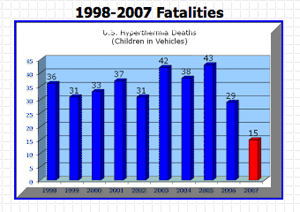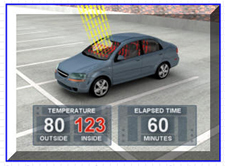
| CONNECTIONS |
IDAHO
ITD
HOME
511 TRAVEL SERVICES
IDAHO
DMV
ITD
NEWS
HIGHWAY
SAFETY
IDAHO STATE POLICE
STATE OF IDAHO
NIATT
NATIONAL
AASHTO
AAMVA
AAA of IDAHO
FEDERAL HIGHWAYS
FEDERAL AVIATION
IDAHO STATE POLICE
NHTSA
NTSB
TRB
U.S. DOT
TRANSPORTER
Archives
Milestones
Comments
Idaho
Transportation
Department
Office of Communications
P.O. Box 7129
Boise, ID 83707
208.334.8005
Fax: 208.334.8563

Cars can become deadly for youngsters —
never leave a child unattended
The responses are strikingly simple – the results shockingly tragic: “I was only going to be inside for a few minutes… I didn’t think it would get that hot…I forgot.”
Whatever the reasons, leaving a child unattended in a vehicle while outside temperatures soar is a deadly combination. It has been a deadly combination 15 times across the nation already this year, including one in Idaho. Last year hyperthermia claimed 29 young victims, and in the decade between 1998 and 2007 it claimed 336, an average of 36 children per year.
 A
study of heat-related deaths to young children from 1995 to 2002 incidated
that 39 percent of the victims were “forgotten” by their
caregiver; 27 percent of the children had been playing in an unattended
vehicle; 20 percent were intentionally left in a vehicle by an adult,
and circumstances were unclear in 14 percent of the cases. The average
age of a car-related hyperthermia death is 21 months; 21 percent of
the victims were one year old; 22 percent were two years of age.
A
study of heat-related deaths to young children from 1995 to 2002 incidated
that 39 percent of the victims were “forgotten” by their
caregiver; 27 percent of the children had been playing in an unattended
vehicle; 20 percent were intentionally left in a vehicle by an adult,
and circumstances were unclear in 14 percent of the cases. The average
age of a car-related hyperthermia death is 21 months; 21 percent of
the victims were one year old; 22 percent were two years of age.
Hyperthermia is an acute condition in which the body produces or absorbs more heat than it can dissipate, usually through excessive exposure to heat. Among those who work or exercise in extremely high temperatures, hyperthermia is manifested in heat stroke or sunstroke. Tragically, it also occurs when young children are left alone in vehicles when the outside temperature soars. Like greenhouses, automobiles absorb and hold heat with deadly consequences for those incapable of escaping.
“Sunlight can heat car interiors to lethal temperatures in just 30 minutes, even if the weather is relatively cool,” according to NewScientist. “Researchers strongly urge parents not to leave children alone in parked cars, no matter how mild the weather.
“Even on relatively mild-temperature days, the internal temperature of a vehicle left in the sun quickly gets very warm – the average rise in one hour is 22 degrees Celsius,” explains researcher Catherine McLaren of Stanford University. “My guess is that parents would be surprised that leaving children in a car is very much like leaving them in a sauna.”
A 2002 study tracked the changes of inside air temperatures of a dark blue, midsize sedan with a medium gray interior.
Temperatures on 16 random summer days ranged between 72 and 96 degrees. Inside the test vehicle, the temperature rose an average of 19 degrees in 10 minutes, 29 degrees in 20 minutes, 34 degrees in 30 minutes and 43 degrees in an hour. Leaving the window down slightly produced little relief. Vehicle interior colors appear to be a major factor in how rapidly automobile temperatures rise.
 In
a 90-degree environment, it takes less than 20 minutes for the inside
of a car to reach 125 degrees. In less than 40 minutes, the inside temperature
can soar to 140 degrees.
In
a 90-degree environment, it takes less than 20 minutes for the inside
of a car to reach 125 degrees. In less than 40 minutes, the inside temperature
can soar to 140 degrees.
“Young children and infants are much more susceptible to heat illnesses than adults,” according to authors of the study. “…Toddlers’ body temperatures rise faster and they lose proportionally more water than adults in hot weather.”
Temperatures do not need to reach triple digits to pose life-threatening conditions for children. Symptoms include lethargy, dehydration, vomiting, diarrhea and a body temperature of up to 104 degrees, according to the Texas Children’s Hospital. Children lose their ability to sweat, resulting in seizures, stroke and ultimately death.
During these hot summer days, please take the following precautions to prevent child deaths:
-
Do not leave a child in an unattended car, even with the windows down.
-
Make sure all occupants leave the vehicle when unloading. Don’t overlook sleeping babies. Check all vehicle seats.
-
Patronize businesses that have drive-through windows or curbside service when running errands.
-
Pay at the pump when refueling so you can watch your children.
-
Always lock your car. If a child is missing, check, the car first, including the trunk. Teach your children that vehicles are never to be used as a play area.
-
Keep a stuffed animal in the car seat, and when the child is put in the seat place the toy in the front as a reminder that a child is in back.
-
Place an item that you will need to take with you, such as a purse or briefcase, in the back seat so you will notice the child in back.
-
Have a plan that your childcare provider will call you if your child does not show up as scheduled.
-
If you notice a child left unattended in a vehicle, call 9-1-1 immediately. If it is very hot and the child is unresponsive, break the window to ventilate the car; apply cardio pulmonary resuscitation techniques to the child if you are so trained.
-
Apply cool, wet compresses or ice to reduce the child’s core body temperature.
Published 7-20-07